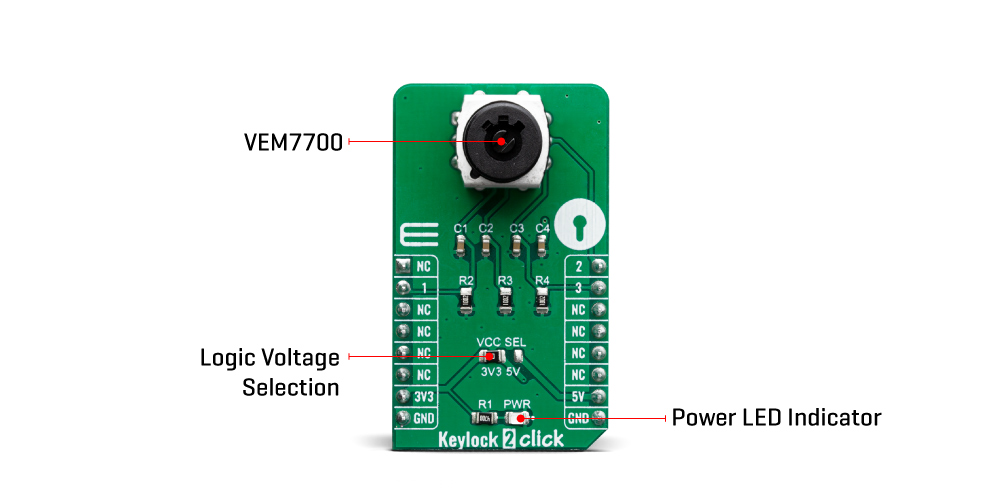



Overview
The Keylock 2 Click Board™ carries an antistatic-process sealed keylock mechanism that has three positions. This board is intended to be used for implementation into applications which require mechanical lock mechanism, as well as for testing the same concepts in early development stage. To determine the position of the key three GPIO pins are used on the mikroBUS line (PWM, INT, and RST pin). Because it can easily be installed in place of the standard lock, it is perfectly suited for development of various home security applications, industrial equipment, etc
The Keylock 2 Click Board™ comes with two keys and a protective cap for the mechanism.
Downloads
Some operating procedures require switching of the electrical power to isolate a machine. After the power has been switched off the key can be released to take the next step, for example opening an access door. The Keylock 2 Click Board™ holds sealed mechanism that are mostly used in automated PC board processing and can be used as an actuator for various applications. If your project require rotary type of actuator the Keylock 2 Click Board™ might be a perfect solution for you.
How Does The Keylock 2 Click Board™ Work?
The Keylock 2 Click Board™ uses SK13AEG13 switch keylock from the company NKK Switches, with three position output states. The key can be removed from the lock in any of the three positions. The Click board package contains two keys and one protective cap.

The SK13AEG13 key has hosing and brushing of high insulating material which withstands over 15 kilovolts of electrostatic discharge, thus providing antistatic protect for the main circuitry. This mechanism has mechanical life of 30,0000 cycles and electrical 20,0000 cycles with moving angle of 45° from position one to three there are no neutral positions.
For switching task is in charge detent mechanism with its spring-operated steel ball, that gives district feel and crisp actuation for accurate switch setting as well as determining the exact position. This is very nice mechanical feedback that gives you more control during every switching movement.
The SK13AEG13 casing is small and compact occupying very little space on the PCB. Mouthing position of this mechanism in vertical (relative to PCB) with 9mm diameter smooth bushing on the top for elegant implementation.
For interaction with the system this boards have three GPIO outputs connected to the mikroBUS™ pins for each position state keylock mechanism has. Logic level on the output pins can be selected with the VCC SEL jumper on the board (JP1) for the desired host board from 3.3V to 5V.
SPECIFICATIONS
| Type | Pushbutton/Switches |
| Applications | Use the three different positions of the mechanism to turn applications on or off, for home security applications, for industrial equipment, etc. |
| On-board modules | Keylock switch with 3 positions |
| Key Features | Durability of minimum 30.000 mechanical cycles, subminiature size of the mechanism, removable key in three positions, |
| Interface | GPIO |
| Compatibility | mikroBUS |
| Click board size | M (42.9 x 25.4 mm) |
| Input Voltage | 3.3V or 5V |
PINOUT DIAGRAM
This table shows how the pinout of the Keylock 2 Click Board™ corresponds to the pinout on the mikroBUS™ socket (the latter shown in the two middle columns).
| Notes | Pin |  |
Pin | Notes | |||
|---|---|---|---|---|---|---|---|
| NC | 1 | AN | PWM | 16 | 2 | Output position 2 | |
| Output position 1 | 1 | 2 | RST | INT | 15 | 3 | Output position 3 |
| NC | 3 | CS | RX | 14 | NC | ||
| NC | 4 | SCK | TX | 13 | NC | ||
| NC | 5 | MISO | SCL | 12 | NC | ||
| NC | 6 | MOSI | SDA | 11 | NC | ||
| Power Supply | 3.3V | 7 | 3.3V | 5V | 10 | 5V | Power Supply |
| Ground | GND | 8 | GND | GND | 9 | GND | Ground |
ONBOARD SETTINGS AND INDICATORS
| Label | Name | Default | Description |
|---|---|---|---|
| LD1 | PWR | - | Power LED Indicator |
| JP1 | ADDR | Left | Power supply voltage selection: left position 3V3, right position 5V |
| SW1 | - | - | Three position key lock mechanism |
KEYLOCK 2 CLICK ELECTRICAL SPECIFICATIONS
| Description | Min | Typ | Max | Unit |
|---|---|---|---|---|
| Logic level | 3.3V | - | 5V | V |
| Applicable current range | 0.1 | - | 100 | mA |
| Mechanical life | 30000 | - | - | Cycles |
| Contact resistance | - | - | 100 | mΩ |
| Insulation resistance | 100 | - | - | MΩ |
| General Information | |
|---|---|
Part Number (SKU) |
MIKROE-3471
|
Manufacturer |
|
| Physical and Mechanical | |
Weight |
0.022 kg
|
| Other | |
Country of Origin |
|
HS Code Customs Tariff code
|
|
EAN |
8606018715060
|
Warranty |
|
Frequently Asked Questions
Have a Question?
Be the first to ask a question about this.




